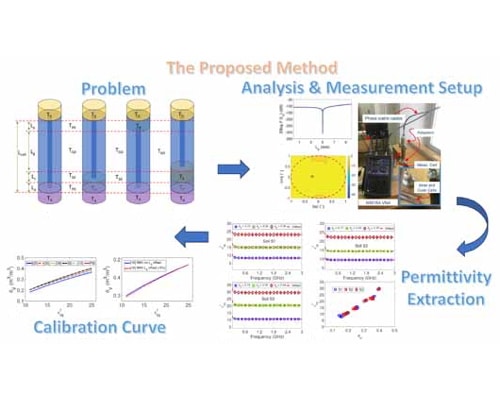Extracting Soil Permittivity Using Uncalibrated, Thickness and Position-Independent Hollow Coaxial-Probe Techniques
Abstract
DOI: 10.1109/TMTT.2024.3523239
IEEEXplore: https://ieeexplore.ieee.org/document/10835139
Device
An accurate soil-moisture evaluation method is proposed using permittivity measurements through microwave hollow coaxial lines (from 0.05 GHz to 3 GHz) with a mathematical framework allowing elimination of the thickness-, position-, and calibration-dependencies simultaneously.
Spectrum
Between 0.05 GHz and 3 GHz
Novelty
Gravimetric method is a conventional technique used to measure moisture of a soil sample. This method is, however, time-consuming (around one day) and labor-intensive. Therefore, there is a need in the literature for an instant and accurate soil moisture measurement method. Indirect methods such as time-domain reflectometry, ground-penetrating radar, tensiometers and microwave methods can be utilized to meet this demand. Among these indirect methods, microwave measurements have the potential of providing an accurate and broadband soil moisture measurement without a constant recalibration. In this study, a new calibration-free de-embedding technique is devised, capable of determining the soil moisture content without the requirement of sample thickness data, need for soil sample position, and a formal calibration procedure which naturally introduces some errors due to imperfect calibration standards utilized in the microwave calibration process. A mathematical framework based on wave-cascading matrix is constructed to achieve our goal. The permittivity-moisture curve is established and extracted permittivity is compared with the Mironov-Fomin model to evaluate performance of the method for tested soil samples.
Application
Microwave-based soil moisture sensing
Performance
(i) A good compromise (a maximum 4.5% absolute difference) between extracted ε_rs^' by our proposed method and predicted ε_rs^' by the Mironov-Fomin model of all tested soils (more than 90% sand) with a range of volumetric water content between 0.15 and 0.44 at 1.4 GHz
(ii) Extracted ε_rs^' by our proposed method (along with the three-pole Debye model) of tested soils follow the permittivity-moisture curve Θ_V=A√(ε_rs^' )-B constructed at 3 GHz with a relatively higher fitting proportion (R^2=0.9894) and lower standard errors (ΔA=0.005 and ΔB=0.007).
